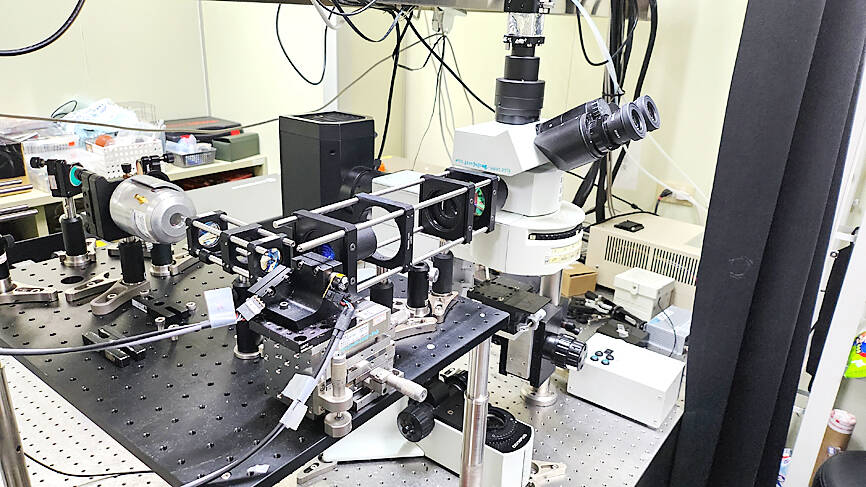Taiwanese scientists have developed the world’s first ultra-high-speed four-dimensional microscope in a breakthrough that enables the observation of electric activity in living neurons.
A multidisciplinary group of researchers from National Taiwan University (NTU) and National Tsing Hua University created the technology and published a study on it with a government grant, the team told a news conference at the National Science and Technology Council yesterday.
The device is thousands of times faster than traditional microscopes and uses artificial intelligence (AI) to increase the image resolution by 10 times, study coauthor and NTU physics professor Chu Shi-wei (朱士維) said.

Photo courtesy of the National Science and Technology Council
The technology represents a leap forward in speed, resolution and image range enabling neural signal transmission to be observed with great detail in real time, compared with existing electronic microscopes that can observe only nonliving specimens, he said.
Using the novel microscope, the team monitored the brain activity of mice to discover that neurons governing motor functions were distributed in parallel, he said.
The arrangement implied that neurons can function independently or be combined to create motor movement patterns, similar to graphics processing units in computers, he said.
That means transmitting a similar signal to different neural networks would lead to distinct results in the cellular body, Chu said.
The microscope’s unprecedented capability can potentially be applied to the observation of electric signals in the human brain to benefit researchers working in neurobiology and AI-related fields, he said.
The human brain’s remarkable energy efficiency would be of interest to chipmakers to reduce the power consumption in servers, he said.
NTU professor of pharmacology Pan Ming-kai (潘明楷) said the human brain uses as little as the equivalent of 12 watts of electricity compared with generative AI, which requires up to 2 megawatts.
The microscope could additionally be used in the study of epilepsy, tremors or dementia, he added.
The study was published last month in the journal Advanced Science.

TRAGEDY STRIKES TAIPEI: The suspect died after falling off a building after he threw smoke grenades into Taipei Main Station and went on a killing spree in Zhongshan A 27-year-old suspect allegedly threw smoke grenades in Taipei Main Station and then proceeded to Zhongshan MRT Station in a random killing spree that resulted in the death of the suspect and two other civilians, and seven injured, including one in critical condition, as of press time last night. The suspect, identified as a man surnamed Chang Wen (張文), allegedly began the attack at Taipei Main Station, the Taipei Fire Department said, adding that it received a report at 5:24pm that smoke grenades had been thrown in the station. One man in his 50s was rushed to hospital after a cardiac arrest

SAFETY FIRST: Double the number of police were deployed at the Taipei Marathon, while other cities released plans to bolster public event safety Authorities across Taiwan have stepped up security measures ahead of Christmas and New Year events, following a knife and smoke bomb attack in Taipei on Friday that left four people dead and 11 injured. In a bid to prevent potential copycat incidents, police deployments have been expanded for large gatherings, transport hubs, and other crowded public spaces, according to official statements from police and city authorities. Taipei Mayor Chiang Wan-an (蔣萬安) said the city has “comprehensively raised security readiness” in crowded areas, increased police deployments with armed officers, and intensified patrols during weekends and nighttime hours. For large-scale events, security checkpoints and explosives

PUBLIC SAFETY: The premier said that security would be tightened in transport hubs, while President Lai commended the public for their bravery The government is to deploy more police, including rapid response units, in crowded public areas to ensure a swift response to any threats, President William Lai (賴清德) said yesterday after a knife attack killed three people and injured 11 in Taipei the previous day. Lai made the remarks following a briefing by the National Police Agency on the progress of the investigation, saying that the attack underscored the importance of cooperation in public security between the central and local governments. The attack unfolded in the early evening on Friday around Taipei Main Station’s M7 exit and later near the Taipei MRT’s Zhongshan

ON ALERT: Taiwan’s partners would issue warnings if China attempted to use Interpol to target Taiwanese, and the global body has mechanisms to prevent it, an official said China has stationed two to four people specializing in Taiwan affairs at its embassies in several democratic countries to monitor and harass Taiwanese, actions that the host nations would not tolerate, National Security Bureau (NSB) Director-General Tsai Ming-yen (蔡明彥) said yesterday. Tsai made the comments at a meeting of the legislature’s Foreign Affairs and National Defense Committee, which asked him and Minister of National Defense Wellington Koo (顧立雄) to report on potential conflicts in the Taiwan Strait and military preparedness. Democratic Progressive Party (DPP) Legislator Michelle Lin (林楚茵) expressed concern that Beijing has posted personnel from China’s Taiwan Affairs Office to its